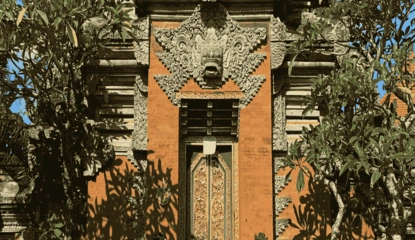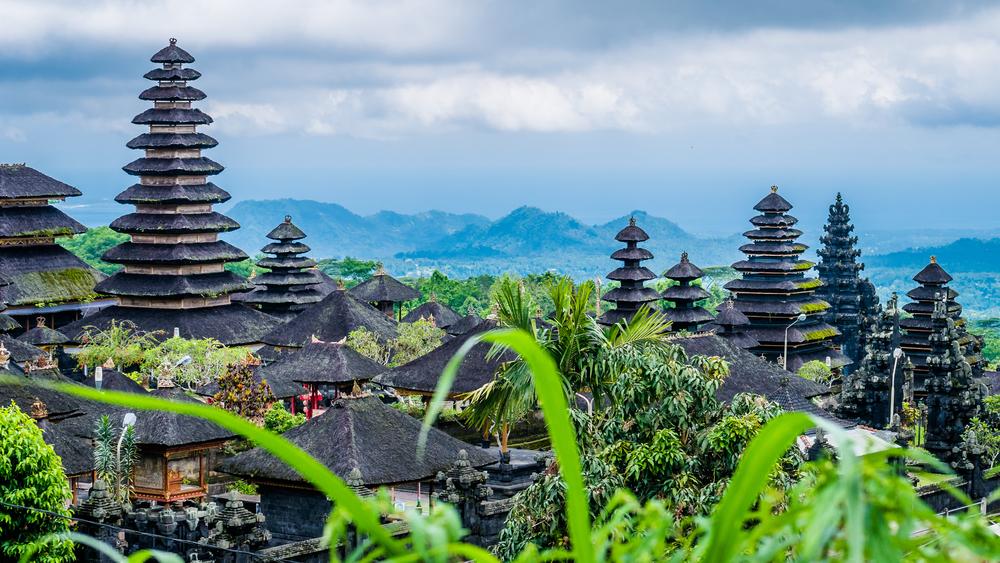Imagine a quiet morning in Bali, with dew still clinging to the leaves, and in the distance, Mount Agung stands majestically, touching the sky.
On the slopes of this sacred mountain lies the island's largest spiritual complex, known as Pura Besakih. This place is not only a tourist destination, but also a spiritual journey. Are you ready to explore more about Pura Besakih?
Get to know Pura Besakih: The Largest and Holiest Temple in Bali.
Besides being the most significant temple, Pura Besakih is the holiest temple for Hindus in Bali. The name Besakih is derived from the Sanskrit 'Wasuki', meaning 'safe'.
Strategic Location at High Altitude
Pura Besakih is situated in Besakih Village, Rendang Sub-district, Karangasem, directly on the southwest slope of Mount Agung, at an altitude of approximately 1,000 meters above sea level.
The location is approximately a 2-hour drive from Ubud or 2.5 hours from Kuta, which can be reached by car, motorbike, or by hiring a local driver.
The location of Pura Besakih was chosen because it is believed to be a sacred area since ancient times. Formerly known as Hulundang Basukih, the village's name was later changed to Besakih.
The name of the temple itself is also related to the mythology of Naga Basuki, a sacred figure who maintains the balance of Mount Mandara, a symbol of protection and harmony of the universe for Balinese Hindus.
When you arrive, be prepared to be greeted by the magical sight of rows of magnificent temples set against a backdrop of lush greenery and a gentle mist that descends slowly, creating an atmosphere that is both serene and captivating.
Nicknamed 'Mother Temple' or 'Mother Temple'
Pura Besakih is nicknamed the 'Mother Temple of Bali' or 'Mother Temple' in Bali. That's because Pura Besakih is 'Huluning Bali Rajya', which means the spiritual center of Bali.
In addition, because Pura Besakih stands in the northeast of Mount Agung, the direction of sunrise, which is believed to be a symbol of life and purity, makes Pura Besakih the soul of all temples in Bali.
Spiritual Meaning of Pura Besakih
For Balinese Hindus, Pura Besakih is the principal place of worship to the Three Gods, namely Brahma (creator), Vishnu (preserver), and Shiva (dissolver).
Here you will see and feel firsthand how every offering made, from incense to whispered prayers, is a form of gratitude and a concrete form of the Tri Hita Karana concept.
Tri Hita Karana is the balance between pawongan (human), palemahan (universe), and Sang Hyang Widhi Wasa (God). In Pura Besakih, Tri Hita Karana is present not only as a philosophy, but as a breath in every spiritual activity of Balinese Hindus.
Excellent Temple Structure and Complex
Located on the slopes of Mount Agung, Pura Besakih has a magnificent structure and complex that will captivate you.
Consisting of dozens of large and small temples
The Pura Besakih complex is not just one sacred building, but a vast and meaningful series of shrines. Consisting of 23 large and small temples, each building has a unique spiritual function.
The main center of Pura Besakih is the Penataran Agung Temple, where major ceremonies take place. While other temples become spaces for meditation, seclusion, or performing personal rituals.
All the temples in Pura Besakih combine to form a living spiritual unity that has been maintained for hundreds of years.
Symbolism in Layout
The layout of Pura Besakih is not just a matter of aesthetics, but is full of deep philosophy. Everything is built following the concept of Tri Hita Karana, the three harmonies on which Balinese Hindus base their lives: man, nature, and God.
The direction of the buildings also has a spiritual meaning. Buildings that point upwards, to the slopes of Mount Agung, symbolize closeness to the Divine.
The buildings that point horizontally, following the line of the land and the cardinal directions, reflect the relationship between people and social life. This layout is full of harmony, so if you come here, don't be surprised if you feel calm and peaceful.
Magnificent Traditional Architecture
The architecture of Pura Besakih is a tangible manifestation of the splendor of ancient Balinese heritage that lives on today. It has a multi-tiered roof made of palm fiber, known as meru, whose number of levels indicates the level of sanctity and reverence for the gods.
On the other hand, intricate stone carvings adorn the walls and shrines, each containing symbols and stories of the ancestors.
The distinctive entrance gate with its bentar temple stands proudly as a barrier between the outside world and the sacred space. All these elements not only beautify the building, but also contain deep and meaningful spiritual values.
Ceremonies and Grand Celebrations at Pura Besakih
As the center of life for all temples in Bali, Pura Besakih is always the venue for various ceremonies and grand celebrations for Hindus, one of which is Ida Bhatara Turun Kabeh.
Ida Bhatara Turun Kabeh
[ALT Image: Pura Besakih - Indonesia Travel]
Ida Bhatara Turun Kabeh is a big ceremony that is performed every year at Pura Besakih. Usually, this activity is held to coincide with the peak of the Bhatara Turun Kabeh ceremony in the month of Kedasa, which is around March-April according to the Balinese calendar.
In this ceremony, Balinese Hindus believe that all manifestations of gods (Ida Betara) descend to earth and reside in Pura Besakih. Thousands of devotees from various regions will come to offer devotion, bring offerings, and follow a series of meaningful rituals.
During the ceremony, every corner of the Pura Besakih complex feels 'alive', not only as a sacred building, but also as a meeting space between humans and the divine.
Panca Wali Krama
[ALT Image: Pura Besakih - Indonesia Travel]
Panca Wali Krama is a grand ceremony held at Besakih Temple once every ten years. This ritual aims to purify the universe and maintain the balance of the cosmos.
During the ceremony, Balinese Hindus from across the island gather and bring large offerings, including sajen bebangkit and banten agung.
When the ritual takes place, the entire temple complex is magnificently decorated, and the atmosphere becomes deeply sacred. This ceremony also serves as a moment of collective introspection for Hindus, reminding everyone that life must remain in harmony with nature, with others, and with God.
Eka Dasa Rudra
https://www.shutterstock.com/image-photo/bali-indonesia-february-2020-people-visiting-1904278300
As the grandest and most sacred ritual in Balinese Hindu tradition, Eka Dasa Rudra is only held once every 100 years at Besakih Temple.
Its purpose is to neutralize negative energies and restore universal balance. The ritual involves the worship of eleven manifestations of Dewa Rudra, symbolizing divine power to cleanse the world from negative forces.
Historically, the last Eka Dasa Rudra was held in 1979, attended by thousands of devotees and national leaders. Due to its extraordinary scale and meaning, this ceremony is regarded as the spiritual pinnacle of Balinese Hinduism.
Preparing for a Visit to Besakih Temple
Before you set foot in Besakih Temple, there are several important things you should prepare:
- Dress appropriately. All visitors are required to wear a sarong (kamen) and sash. If you don’t bring one, you can easily rent it at the entrance area.
- Come in the morning. The early hours offer a cooler, calmer, and more serene atmosphere, perfect for admiring the temple’s architecture while soaking in its spiritual vibe.
- Hire a local guide. A guide can help you understand the symbolic meanings and history behind each temple area, making your experience more memorable.
- Respect worshippers. Avoid disturbing people in prayer, keep away from restricted sacred areas, and maintain silence to preserve the temple’s holy ambiance.
Estimated Budget for Visiting Besakih Temple
- Entrance ticket: Rp60,000 - Rp100,000 (includes sarong and sash rental)
- Local guide (optional): Rp50,000 - Rp100,000
- Transportation (round trip from Ubud/Kuta): Rp300,000 - Rp500,000, depending on the vehicle
- Food and drinks nearby: Rp30,000 - Rp50,000
- Estimated local expenses: from Rp150,000 - Rp650,000
Flights to Bali (round trip):
- From Jakarta: Rp1,000,000 - Rp1,800,000
- From Surabaya: Rp800,000 - Rp1,400,000
- From Makassar: Rp1,200,000 - Rp2,000,000
From Medan: Rp1,500,000 - Rp2,500,000
Total estimated trip cost: from Rp1,000,000 - Rp3,000,000 per person
Attractions Around Besakih Temple
Don’t rush home after visiting Besakih Temple, explore nearby gems in East Bali:
-
Mount Agung Basecamp
The starting point for trekking up Bali’s tallest and most sacred volcano. Many hikers begin here at night to catch the sunrise from the summit.
-
Bukit Jambul
A scenic viewpoint on the way to Besakih, offering rice terraces and lush valleys. A perfect photo stop and rest area.
-
Sidemen Village
A peaceful haven famous for its wide rice fields, traditional weaving, and authentic slow-living atmosphere.
-
Tirta Gangga
An enchanting former royal water palace with stone ponds, fountains, and statues, ideal for both sightseeing and photography.
Why Visit Besakih Temple?
Besakih is more than just a photo spot or an ancient architectural wonder, it is a living spiritual center filled with deep meaning.
Solo travelers often come here seeking tranquility and introspection.
Couples on honeymoon will find Besakih a romantic and meaningful alternative to Bali’s beaches.
Families with children can use the visit as an educational journey into Balinese culture and spirituality.
In short, whether you travel alone, with a partner, or with family, Besakih Temple offers a unique way to touch your heart and create unforgettable memories.
Here, you’ll experience the soul of Bali, alive for centuries at the island’s spiritual core.
So, when are you ready to explore Bali’s most sacred and soul-stirring side?












